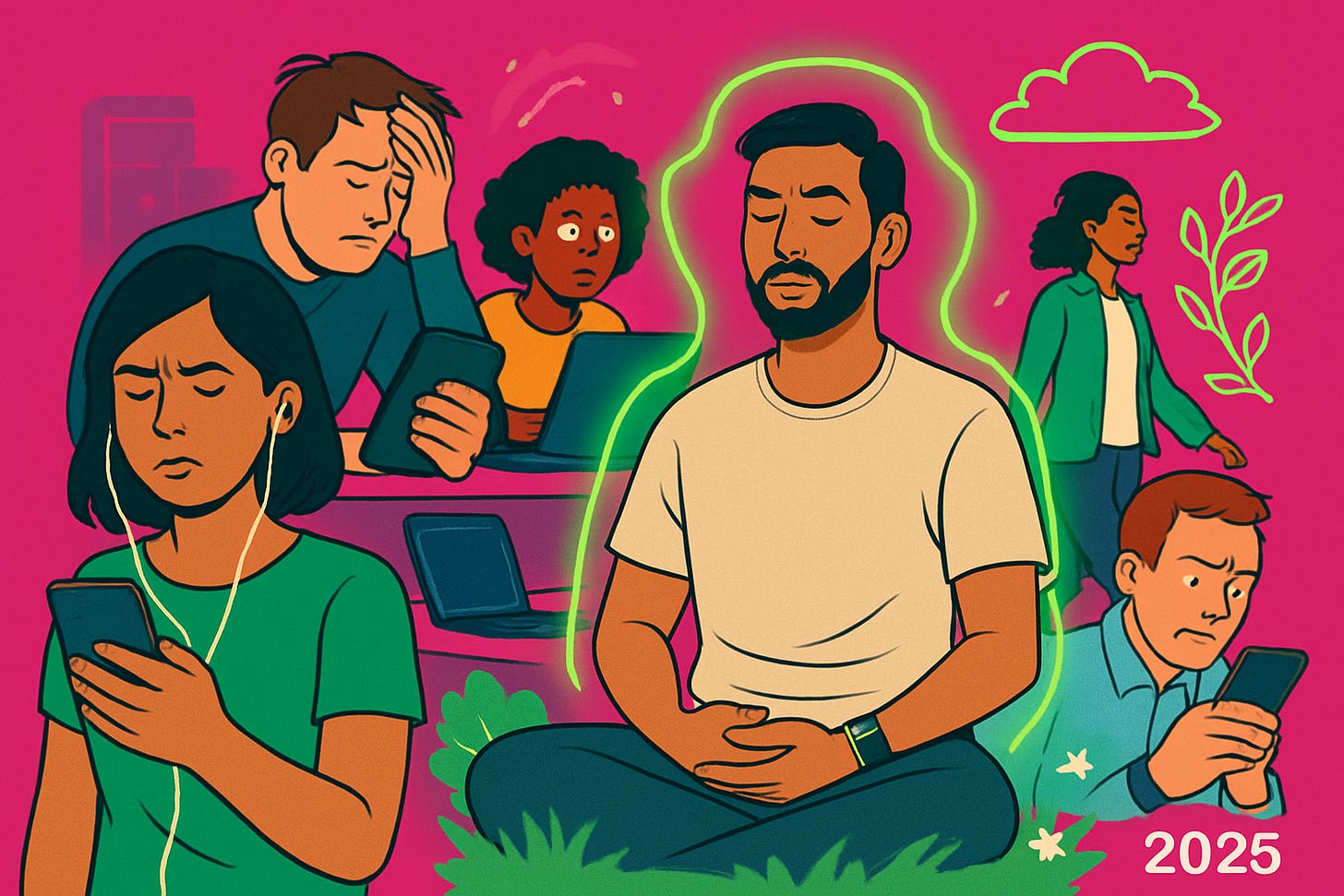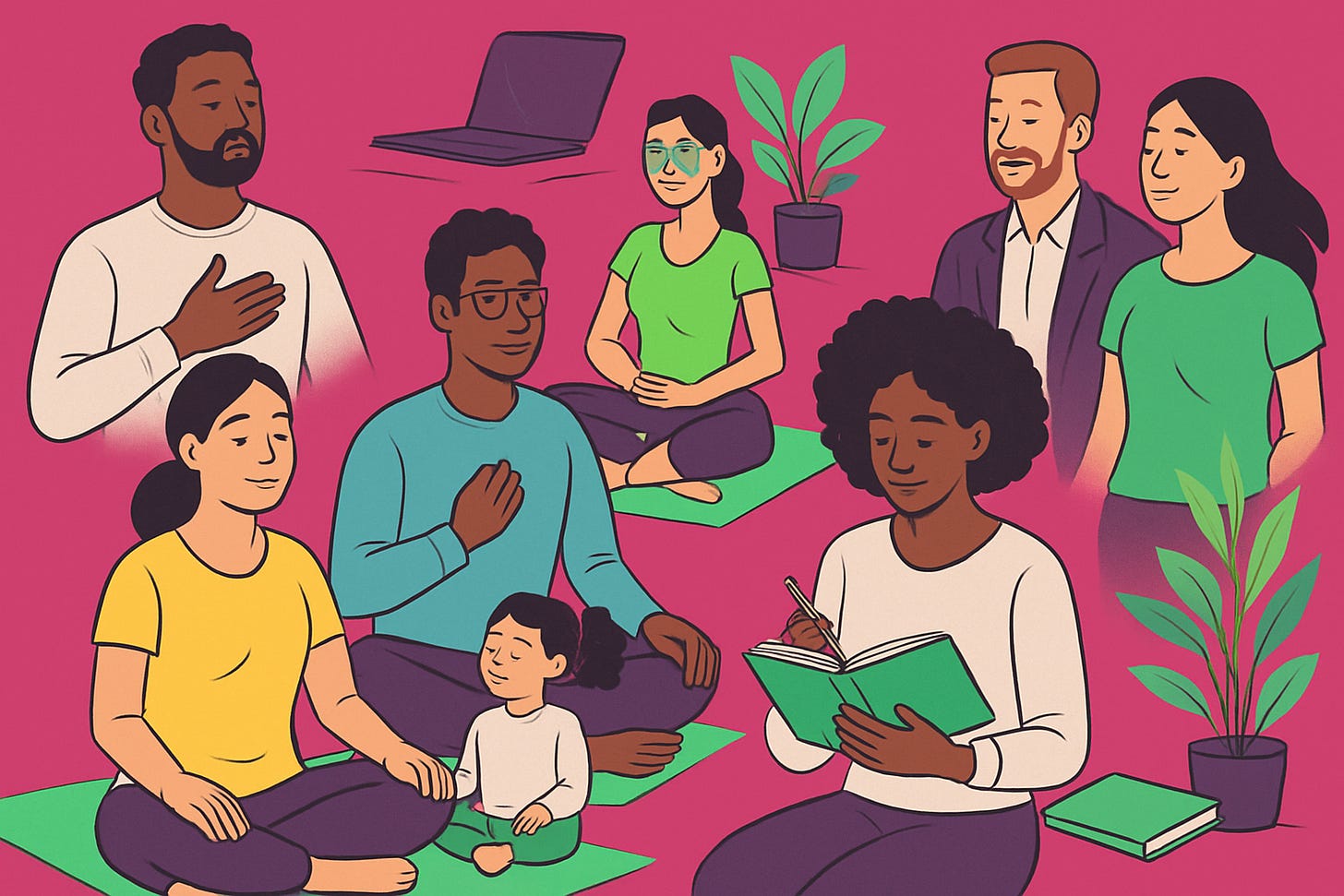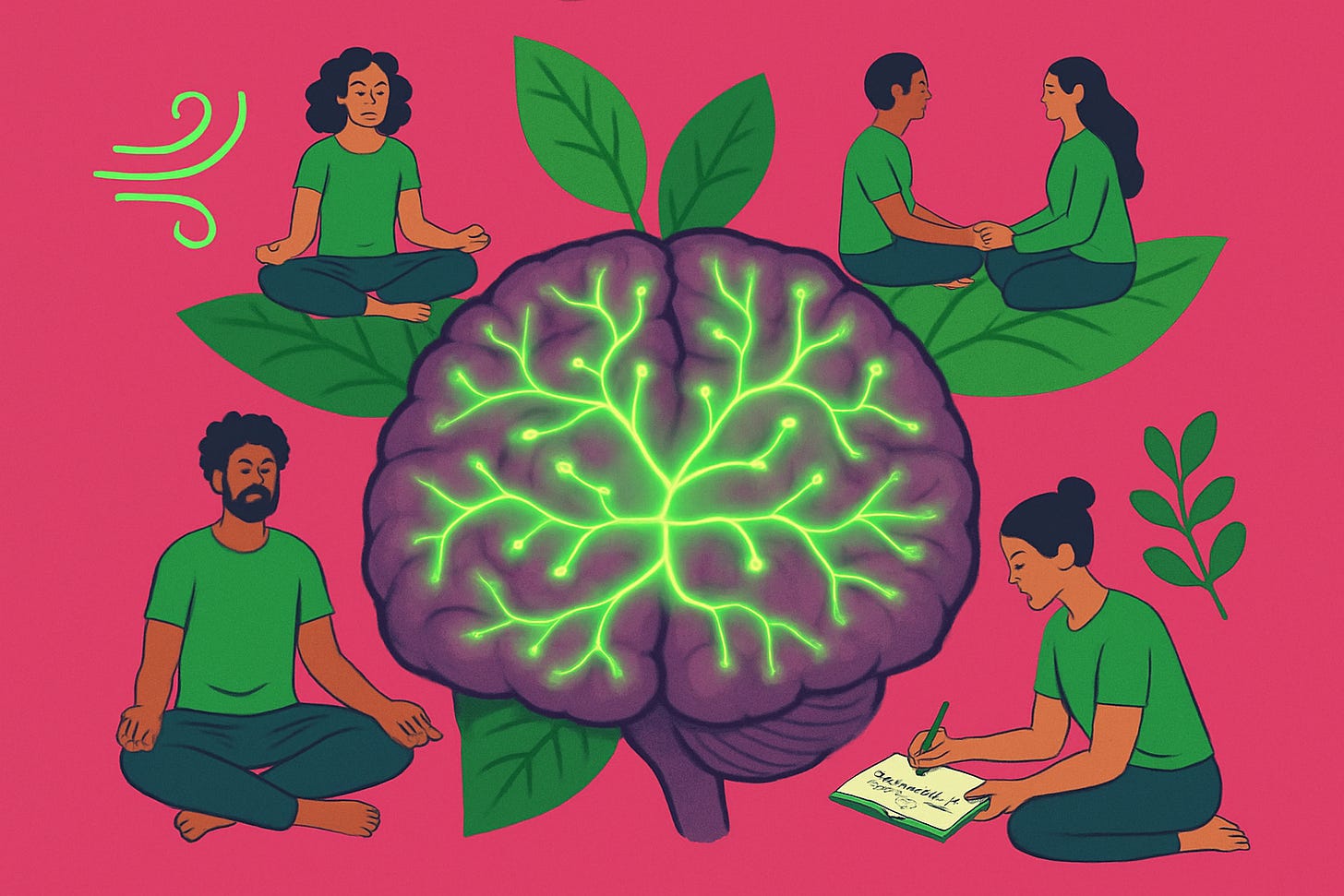7 Simple Ways To Achieve Inner Calm
Inner calm is essential for building a life where you're not just grinding, surviving each and every day.
Did you know over 60% of adults feel more stressed than ever as 2025 speeds ahead? Between endless notifications and a world that never seems to pause, finding inner calm is more than just a nice-to-have—it’s a survival skill.
The good news? Achieving inner calm isn’t reserved for monks or meditation gurus. Anyone can nurture it, even in our tech-heavy, always-on routines.
In this post, you’ll discover seven straightforward, science-backed ways to unlock inner calm this year. Ready to feel more centered and resilient? Let’s dive in.
The Modern Challenge: Why Inner Calm Matters in 2025
The Escalating Pace of Life
In 2025, life moves at lightning speed. Technology connects us 24/7, remote work blurs home and office, and notifications never stop. It's no surprise that over 60% of adults report higher stress now than just a few years ago. The digital world offers convenience but also creates a constant undercurrent of anxiety. According to Digital Detox Statistics 2025, the average person checks their phone more than 90 times a day—a clear sign that finding inner calm is more challenging than ever.
The Impact on Mental and Physical Health
This relentless pace isn't just exhausting—it's taking a real toll on our minds and bodies. Chronic stress from always being "on" can lead to burnout, trouble sleeping, and even a weakened immune system. Recent studies show a sharp rise in anxiety and depressive symptoms following the pandemic, especially among those juggling multiple roles at home and work. Without strategies to foster inner calm, these pressures can quietly erode our overall well-being.
The Benefits of Inner Calm
But there’s good news: cultivating inner calm isn’t just about feeling relaxed. It’s a proven way to boost decision-making, strengthen relationships, and build emotional resilience. In fact, mindfulness programs in workplaces have been shown to reduce employee stress by 32%. People who practice inner calm also report clearer thinking and a greater sense of purpose. Imagine facing daily challenges with steady confidence instead of overwhelm.
What’s Different in 2025?
So, what’s changed this year? Hybrid work is now the norm, and digital distractions are everywhere. Social dynamics have shifted, making it harder to disconnect and recharge. The demands of modern life require updated strategies to intentionally create space for inner calm. It's not about escaping technology, but about learning to pause and reset—even for a few moments each day.
The Promise of Simple, Science-Backed Solutions
The best part? Achieving inner calm is completely within reach, even if you’re not a meditation guru. Science shows that small, consistent habits can make a big difference. The seven methods covered in this article are practical, evidence-based, and designed for real life. Whether you’re a busy parent, a remote worker, or just feeling stretched thin, you can start building inner calm—one simple step at a time.
7 Simple Ways To Achieve Inner Calm In 2025
Ready to make inner calm your new superpower in 2025? The world may feel faster than ever, but you don’t need to overhaul your life to find peace. Instead, you can build inner calm right into your daily routine—one small, science-backed step at a time.
Below, discover seven simple, proven ways to nurture inner calm this year. Each is easy to start, flexible, and designed for real people with busy lives. Let’s dive in.
1. Practice Mindful Breathing
Breathwork is one of the fastest ways to anchor yourself in inner calm, especially when life feels overwhelming. Science shows that mindful breathing activates your parasympathetic nervous system—your body’s natural “rest and digest” mode. This reduces cortisol, the main stress hormone, and helps you feel grounded.
Simple Breathing Techniques:
Box Breathing: Inhale for 4 seconds, hold for 4, exhale for 4, hold for 4. Repeat.
4-7-8 Breathing: Inhale for 4 seconds, hold for 7, exhale for 8. Repeat three times.
Calm.com notes, “Deep, conscious breathing can have a profoundly calming effect.” Even busy dads find a few minutes of breathwork after work helps them transition into family time with more inner calm.
Integrating Mindful Breathing:
Practice during commutes, before meetings, or while waiting in line.
Use guided breathing apps to stay consistent.
Try five minutes a day—studies show just this can lower anxiety by 20%.
Here’s a quick comparison of popular breathwork methods:
Mindful breathwork is your portable tool for inner calm—no special equipment needed.
2. Embrace Digital Detox Moments
Ever feel like your phone is running your life? Constant notifications and screen time can drain your focus and disrupt sleep, making inner calm harder to reach. That’s where digital detox comes in—intentional breaks from screens to refresh your mind.
Easy Ways to Start a Digital Detox:
Enjoy phone-free meals or walks.
Set “Do Not Disturb” hours before bed.
Create tech-free zones at home for family connection.
Take nature walks without any devices.
Families who set up tech-free dinner times or weekend mornings notice more laughter, deeper conversations, and a boost in inner calm. According to Calm.com, “Step back from overstimulation and reconnect with simple moments.”
Research shows that screen breaks improve focus and mood. In fact, digital detox can enhance both sleep and productivity, as detailed in this Impact of Digital Detox on Mental Health guide.
Action Step: Start with just one hour a day of no screens, then build from there. Notice how your inner calm grows as your mind gets a break from the digital buzz.
3. Create a Personal Mindfulness Ritual
A mindfulness ritual doesn’t need to be elaborate—just intentional. It’s a daily anchor that brings you back to inner calm, even when chaos swirls around you.
Popular Ritual Ideas:
Morning journaling or gratitude lists.
Tea or coffee meditation—savoring each sip.
Mindful walks, focusing on sights and sounds.
Journaling three things you’re grateful for each morning can shift your mindset and nurture inner calm. Calm.com says, “Gratitude can shift your focus… It’s a fast-track to inner peace.” Guided meditations or mindful reading can also set a positive tone for your day.
Science Backs Rituals: Research shows that consistent rituals help form calming habits and reduce daily stress. The key isn’t perfection—it’s showing up, even for a few minutes. Over time, your brain associates these moments with inner calm, making it easier to return to peace under pressure.
4. Move Your Body with Purpose
Physical movement is a powerful ally for inner calm. Intentional movement helps release tension, lower stress hormones, and boost your mood.
Simple Ways to Move:
10-minute yoga routines (great for busy parents).
Mindful stretching at your desk.
Walking in nature or around your neighborhood.
Tai chi or gentle bodyweight exercises.
Regular movement is linked to lower stress hormones and better emotional balance. Calm.com encourages us: “Access nature… even simple walks bring benefits.” Whether you choose yoga, a brisk walk, or a dance break, the goal is purposeful movement that you enjoy.
Tips for Busy Schedules:
Schedule movement like any other important meeting.
Pair it with daily tasks (stretch while the coffee brews).
Invite your kids or friends for a walk—make it social.
Moving your body, even briefly, helps you reclaim inner calm throughout your day.
5. Set Healthy Boundaries for Peace of Mind
Healthy boundaries are essential for protecting your inner calm. Boundaries help you manage your energy, time, and emotional wellbeing—especially in a world that often demands more than you can give.
What Are Boundaries?
Saying “no” to extra commitments when you’re stretched thin.
Blocking out downtime on your calendar.
Clearly communicating your needs to colleagues and loved ones.
Overcommitment and people-pleasing are major stressors. Dads who reserve family time on their calendar, for example, report feeling more present and less frazzled—leading to deeper inner calm.
The Benefits:
Reduced anxiety and improved relationships.
More space for activities that restore inner calm.
Calm.com reminds us, “Self-care isn’t a luxury; it’s a necessity.” If guilt or resistance pops up, remember: setting boundaries is an act of self-respect, not selfishness.
6. Cultivate Self-Compassion and Acceptance
Inner calm flourishes when we treat ourselves with kindness. Self-compassion means offering yourself understanding during tough moments, instead of harsh criticism.
How to Practice Self-Compassion:
Use positive self-talk—replace “I failed” with “I tried my best.”
Forgive yourself for mistakes, big or small.
Notice negative thoughts and let them pass without judgment.
Acceptance is another key ingredient. Calm.com says, “Accepting a situation can take away its power over us.” When you stop fighting reality, you free up energy for inner calm.
Quick Exercises:
Take a self-compassion break: pause, acknowledge your struggle, and speak to yourself as you would a friend.
Try affirmations like, “I am enough as I am.”
Research shows self-compassion reduces stress and boosts resilience. The more you practice, the more natural inner calm becomes—especially during setbacks.
7. Foster Meaningful Connections
Strong, supportive relationships are a cornerstone of inner calm. When you feel seen and supported, your stress melts away faster.
Ways to Deepen Connections:
Practice mindful listening—put your phone away and really hear your loved ones.
Schedule quality time: family check-ins, “walk and talks” with friends.
Express gratitude for the people who lift you up.
Calm.com encourages us: “Cultivate relationships that feed your soul.” Data reveals that people with strong social bonds experience lower stress and greater happiness—key for lasting inner calm.
Building a Supportive Network:
Join a community group or online forum.
Reach out to friends regularly, even with a quick text.
Be vulnerable and present in your interactions.
In a digital world, real connection is a powerful antidote—one that reliably restores inner calm.
The Science Behind Inner Calm: What Actually Works?
Finding inner calm isn’t just wishful thinking—it’s backed by neuroscience, habits, nature, and community. Let’s break down the proven science so you can see exactly how these tools bring inner calm within reach, no matter how busy your 2025 gets.
How Mindfulness Changes the Brain
Did you know inner calm actually reshapes your brain? Research shows regular mindfulness practice increases gray matter in regions linked to emotion regulation and self-awareness. Meditation, even just a few minutes daily, can shrink the amygdala—the part of your brain responsible for stress and fear responses.
According to Mindfulness and Technology, integrating mindful habits with modern tools can further enhance these benefits. This means that practicing inner calm isn’t just relaxing—it’s rewiring your brain for resilience.
The Role of Routine and Consistency
Inner calm thrives on habit. When you repeat calming activities—like gratitude journaling or mindful breathing—you form new neural pathways. Over time, these routines make it easier for your mind to return to a peaceful state, even during chaos.
For example, jotting down three things you’re grateful for each morning can retrain your brain to focus on the positive. Consistency, not perfection, is the secret to building lasting inner calm.
Adaptogens and Natural Supports
Modern science supports the use of natural remedies for inner calm. Adaptogens like ashwagandha and lemon balm can help your body adapt to stress, supporting mood and resilience. Studies suggest these supplements may lower cortisol and help restore balance after long days.
If you’re curious about natural supports, consult with a healthcare provider to see if adaptogens fit your journey to inner calm. Small additions like herbal teas can make a noticeable difference.
The Power of Community Support
Don’t go it alone—community amplifies inner calm. Group practices, like mindfulness circles or even family gratitude rituals, increase accountability and emotional safety. Research from Calm.com notes that “supportive networks foster lasting calm” by providing encouragement and shared experience.
Building a circle of support helps you stay motivated and offers practical tools when life feels overwhelming.
Integrating Multiple Strategies
The magic happens when you blend these science-backed approaches. Mix breathwork, movement, gratitude rituals, and supportive connections for a powerful boost to inner calm. No single method fits everyone—experiment with different combinations to discover what works best for you.
Remember, the journey to inner calm is ongoing. Start small, stay curious, and celebrate every step forward.
Overcoming Common Obstacles to Inner Calm
Achieving inner calm in 2025 isn’t always easy. Life throws curveballs—busy schedules, doubts, and unexpected stressors can get in the way. But these hurdles aren’t insurmountable. With the right strategies, you can make inner calm a steady part of your daily life.
Time Constraints and Busy Schedules
Feeling like there’s never enough time? You’re not alone. Many people struggle to fit inner calm practices into packed calendars. Micro-practices offer a solution—think two-minute breathing exercises or mindful pauses during commute times.
Even brief digital detox moments can make a difference. According to Digital Detox and Employee Productivity, intentional breaks from technology help reduce fatigue and boost focus. Try scheduling tech-free windows or using commute time for mindful reflection.
Skepticism and Self-Doubt
You might wonder if inner calm is even possible for you. It’s normal to feel skeptical, especially if you think calm requires hours of meditation. Good news: science shows that even a few minutes of mindfulness or breathwork can create real change.
Start small and notice the shifts. Remind yourself that inner calm is a journey, not a destination. Celebrate every bit of progress, no matter how minor it seems.
Setbacks and Inconsistency
Nobody’s perfect. Missing a day or two—or even a week—doesn’t mean you’ve failed. Setbacks are a natural part of building any new habit. Use tools like habit trackers or gentle reminders to get back on track.
Reflect on what triggered the lapse and adjust your routine. Small wins, such as a single mindful breath before bed, keep your inner calm practice going strong.
External Stressors and Unpredictable Events
Life is full of surprises—some pleasant, others not so much. When stress spikes, lean on your inner calm toolkit: acceptance, flexible boundaries, and support systems. These help you adapt when things go off script.
Real-life tip: practice a calming breath before tough meetings or family discussions. With time, these techniques become second nature, helping you stay grounded.
Making Calm a Family or Community Value
Inner calm thrives in community. Invite family or friends to join you—try shared tech-free meals or group mindfulness rituals. Not only does this boost accountability, but research shows that collective calm practices increase benefits for everyone.
Start with one simple activity and watch how the ripple effect brings more peace to your home and relationships.
Frequently Asked Questions About Achieving Inner Calm
Curious about how to make inner calm part of your daily life? Here are answers to the most common questions we hear:
What is inner calm and how is it different from relaxation?
Inner calm is a steady state of peacefulness and clarity, while relaxation is a temporary release of tension.How long does it take to notice results from these practices?
Most people feel small shifts in a few days, with more lasting change after a few weeks of regular practice.Can these methods help with chronic anxiety or only daily stress?
Science shows these tools can support both, though severe anxiety may require professional care.Do I need special tools, apps, or supplements to get started?
No—just a willingness to try is enough. Apps and supplements can enhance your routine if you choose.How can I stay motivated to practice inner calm in the long run?
Set reminders, track progress, and celebrate small wins to keep your calm habits strong.
If you’re ready to take your leadership journey to the next level in 2025—whether that means showing up with more confidence, building stronger connections, or finding more joy in both your professional and personal life—why not put these strategies into action with a supportive community?
You don’t have to figure it out alone. Join a group of like-minded Parents and Leaders who are committed to growing, learning, and leading with purpose.
If you want live coaching, real-world resources, and a space to become your best self, Sign up for the next workshop! The link to the upcoming one can found here.







